
Okanagan Vacation 12 - Behind Brin de Soleil
June 29th, 2011
On my second walk behind Brin de Soleil, I noticed these beautiful red and yellow wildflowers in bloom. "Blanketflowers", I think they're called--gaillardia aristata. Showy cultivars of this species are popular in gardens.

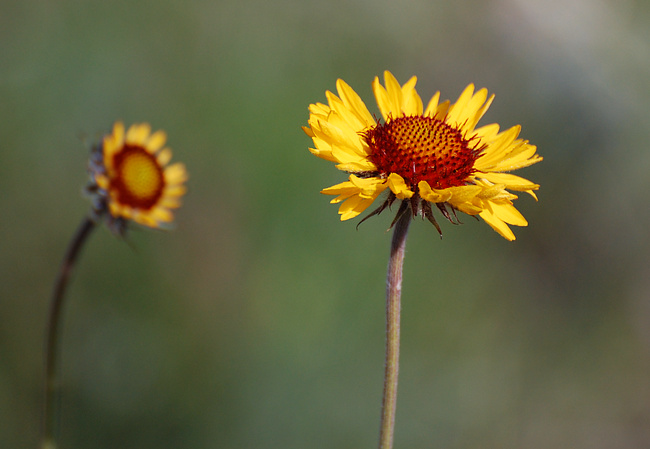
1680x1050 wallpaper
I also discovered a Pygmy Nuthatch at the nest. She was flying back and forth, carrying insects in her bill and poking her head into a hole that looked no bigger around than a quarter--hard to believe there was a nest of baby birds in there!
She wouldn't actually go to the nest with me close by, though. She just perched on the tree, chirping indignantly. I snapped a few pictures and left her alone.
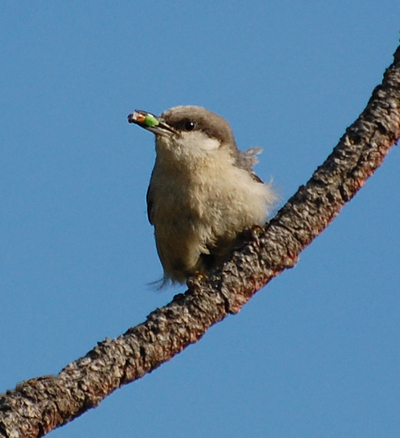
Okanagan Vacation 11 - Max Lake
June 28th, 2011
A couple photos from our trip to Max Lake:
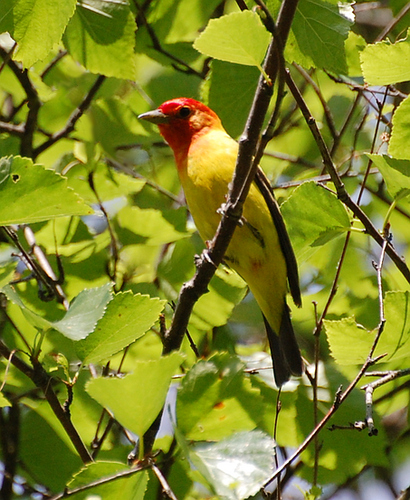
Western Tanager

Ornate Tiger Moth
Okanagan Vacation 10 - Apex Mountain (beasties)
June 27th, 2011
Another point of interest up Apex Mountain was the colony of Yellow-Bellied Marmots. We ran into them in a few places. Like woodchucks, but svelter and cuter. We confused them with these guys at first, until we noted the marmots' larger size and facial markings.

1680x1050 wallpaper
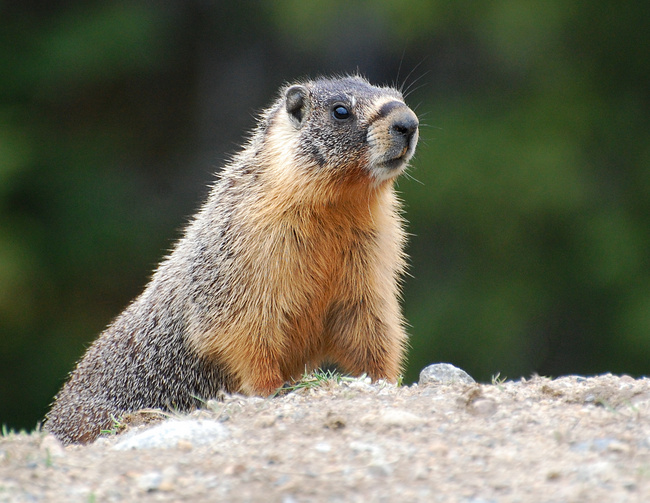
1680x1050 wallpaper

Okanagan Vacation 9 - Apex Mountain (birds)
June 26th, 2011
Our next trip was up another snow-capped mountain. We had heard there was a chairlift up there that operated even in summer. We figured it would at least be a fun ride and might be a way to see some truly alpine birds. Alas, our information was apparently out of date.
The ski village, though, was a gold mine of Clark's Nutcrackers, a species I'd been seeking since my arrival. Clark's Nutcracker is one of the west's truly unique birds, with no close cousin in the east (though it does have one in Eurasia.) It's a corvid (crow relative) of the Rocky Mountains specialized for eating pine seeds. Like a squirrel, it caches large amounts of food in fall and uses these caches to survive the harsh winters. Clark's Nutcrackers form long-lasting pair bonds and males contribute equally to childrearing, even brooding eggs in the nest.
The village was teeming with them. They were backyard birds there, clearly comfortable around humans and human habitation.
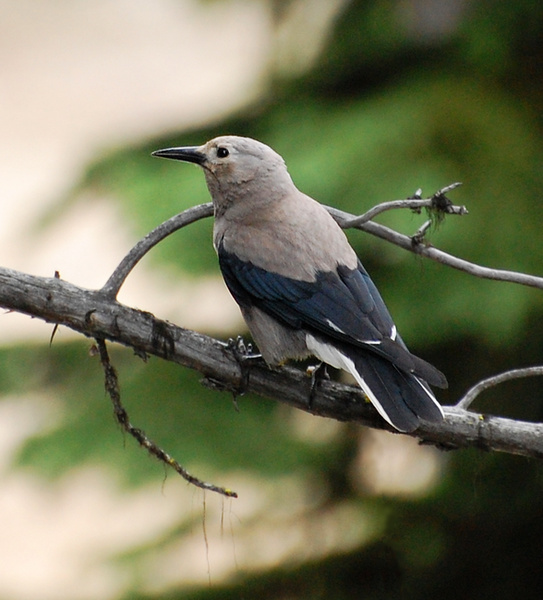
"Corvids" was the theme of the trip, in fact. We saw lots of Gray Jays. Gray Jays occur coast to coast in Canada's mountainous and boreal regions. (The nearest place to find them in our area is Algonquin Park.) They're big fluffy gray and white birds, quite tame, even known to feed from the hand--sort of like overgrown chickadees!
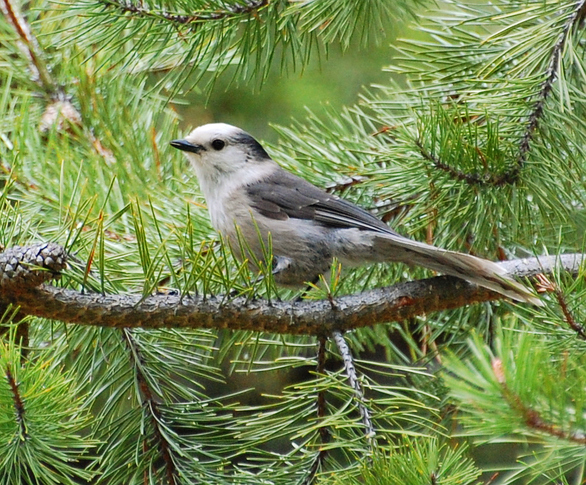
A Steller's Jay made a brief appearance amidst one flock of Gray Jays.

Okanagan Vacation 8 - Behind Brin de Soleil
June 24th, 2011
There was a hiking trail behind Brin de Soleil, winding up and along the slope. The owners pointed it out to me. It went through private property, technically, but property used only to graze cattle and only at certain times of the year. Guests at the B&B were welcome to use it--they had even cut a hole in the barbed wire fence so you could get through.
It was beautiful up there, the view even more panoramic than from the front yard, and I saw some great birds, including two lifers. My first MacGillivray's Warbler occurred here. MacGillivray's is a shy, skulking warbler (like its close relative, our own Mourning Warbler)--but this one had the single best response to pishing that I've ever seen. He had been laying low in the underbrush and not making a sound. As soon as I pished just a little, he hopped around in the bushes for the next five minutes, chirping constantly, giving me excellent views of himself.
On the way back from one walk, on a post just outside Brin de Soleil, I finally found a California Quail who was willing to sit still for the camera! I inched towards him, photographing as I went. He didn't flush into the grass until I was about ten feet away. Result: a wallpaper-quality shot.

1680x1050 wallpaper
I also got my first photograph of a magpie on that walk.
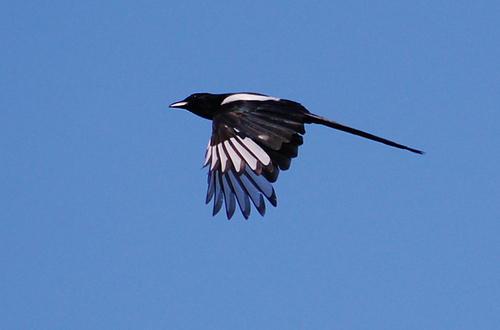
Mule Deer were a common sight, as they were elsewhere in the Okanagan. We saw the familiar White-Tailed Deer too, but Mule Deer were the majority, instantly recognizable by their oversized ears.
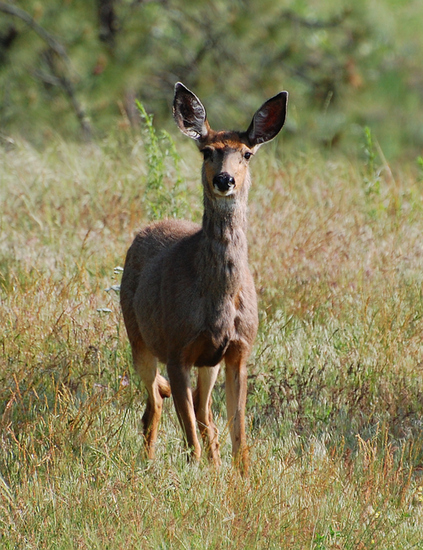
I was fascinated by the way Mule Deer moved. They would trot along the slope with this incredibly gay, light-footed, bounding gait. Like they were weightless. Or like something out of a Walt Disney movie, or Pepé Le Pew chasing Penelope Pussycat. Back home I learned that this seemingly cheerful gait is actually a form of stotting--a way of demonstrating ones fitness to a potential predator (in this case, me.). Mule Deer do it, White-Tailed Deer don't. It's as if the animal is saying, "look at this. Look how confident I am. Look how easily I move. I'm not even bothering to break into a proper run. You should hunt someone else 'cause you're not gonna catch me."
Here's some video to show you what I'm talking about. In this case it's juveniles stotting for the fun of it. Watch them from about 15 seconds in.
Okanagan Vacation 7 - Arrival at Brin de Soleil
June 23rd, 2011
Our second B&B, Brin de Soleil, was also wonderful. The owners were very friendly and went above and beyond to make our stay comfortable. It was actually built on the side of the mountain--the driveway was so steep it required a switchback! So we got a gorgeous panoramic view of the Okanagan valley every time we went out in the front yard.

Photo by Michael Britton, wallpaper available.
Okanagan Vacation 6 - Mount Kobau
June 22nd, 2011
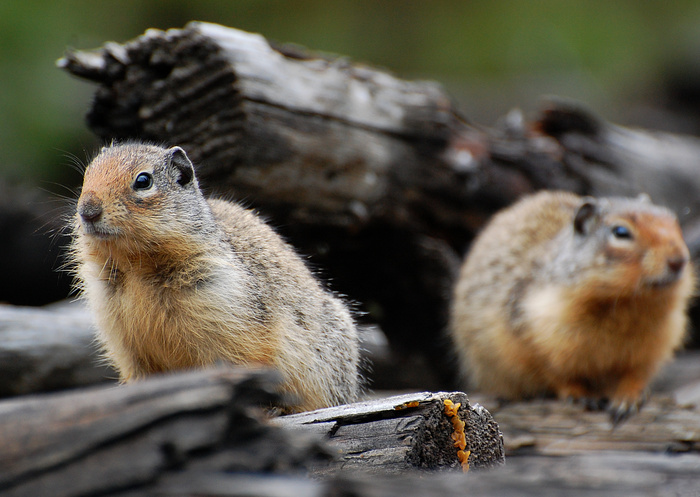
Columbian Ground Squirrels
We did a lot of driving in the mountains this trip. Mount Kobau was the first serious expedition. Our original plan was to go to the top. Some unusual birds nest at the very peaks of tall mountains in the Canadian Rockies--birds adapted to live and forage in treeless alpine tundra, such as the Gray-Crowned Rosy Finch. But when we got as high up as we could drive, we found that the 1km hiking trail to the top was unnavigable without winter boots--possibly even snowshoes! So there our trip ended.

Sagebrush, sub-alpine conifers and patches of snow near the peak of Mount Kobau. Photo by Michael Britton, wallpaper available.
It was a peak moment for me. Literally (well, almost) and figuratively. Tall, majestic, primeval-looking conifers dominated the landscape. The air was cool. A little rivulet of a stream trickled along, and Oregon Juncos watched us from the rocks. I felt still and peaceful and like I'd come to one of the most untouched places on earth. From above, from the very treetops, trickled the haunting song of the Hermit Thrush.
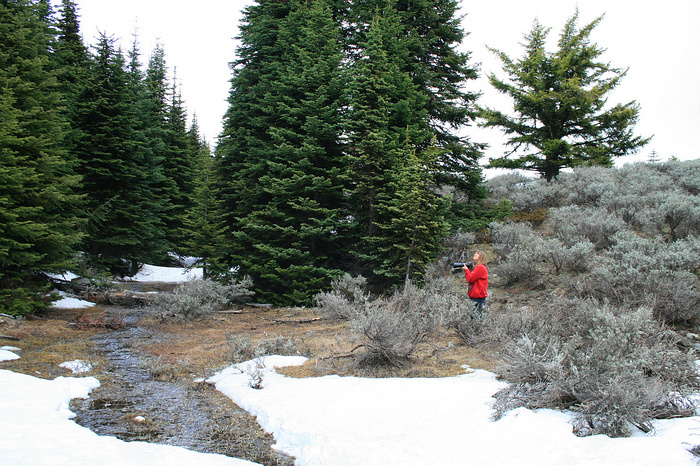
Photo by Michael Britton
Yes, sagebrush and snow. In the same landscape. In June. Who knew?
I tried to photograph the juncos, but they did not wish to be photographed. The stars of the day ended up being a colony of Columbian Ground Squirrels we ran into on our way up the mountain. They seemed to have a home in a big blackened brushpile, likely remnants of the forest fire that swept through the Okanagan in 2003. They retreated to the brushpile when we approached--but couldn't resist poking their heads back out to see what we were up to.
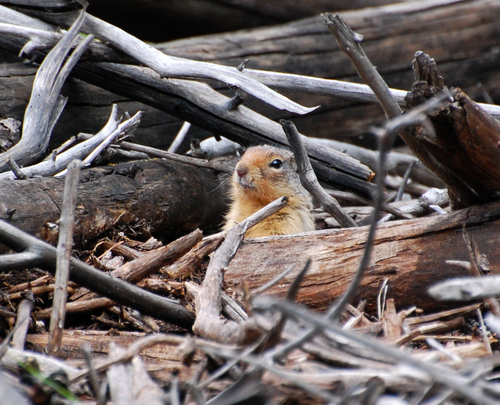
Eventually they decided that we were mostly harmless.
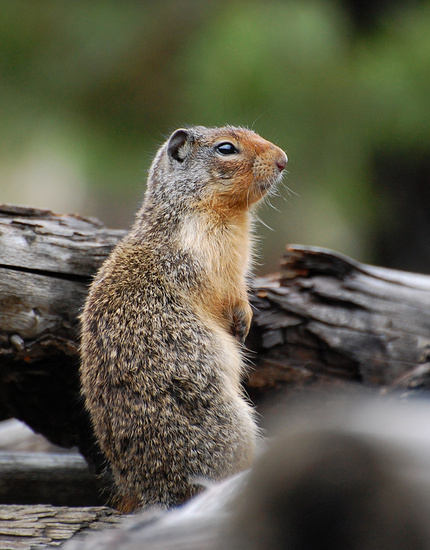
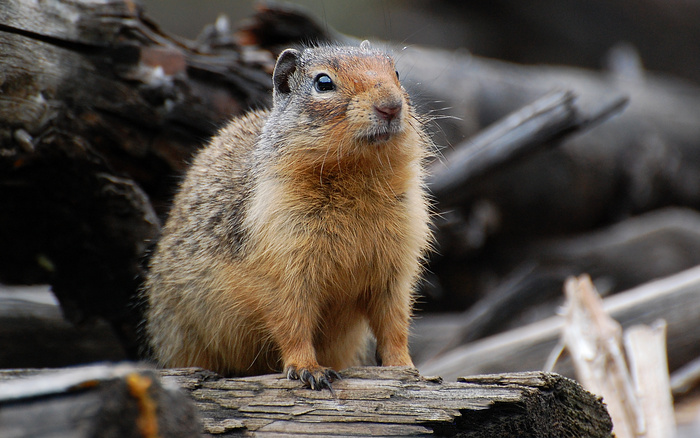
1680x1050 wallpaper
Okanagan Vacation 5 - Kruger Mountain
June 19th, 2011
Other points of interest on the trip up Kruger Mountain:
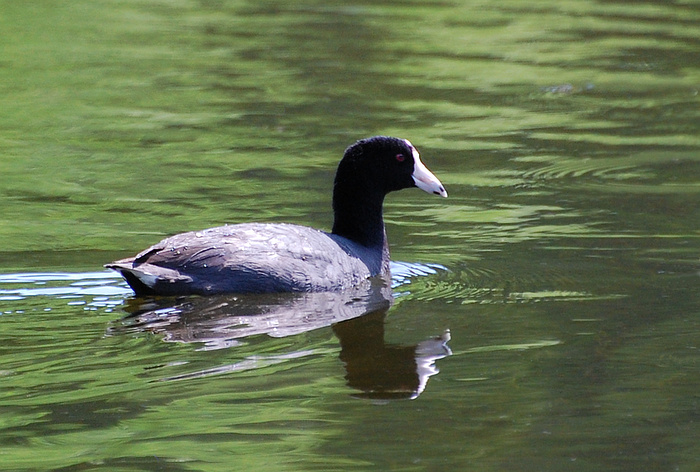
1680x1050 wallpaper
This American Coot was sharing the mountain pond with the two pairs of Ruddy Ducks--apparently peaceably. Coots are part of the rail family and are not ducks, despite appearances. They show up in Ottawa in migration, but are uncommon enough here that it was a treat to get to photograph one at close range.
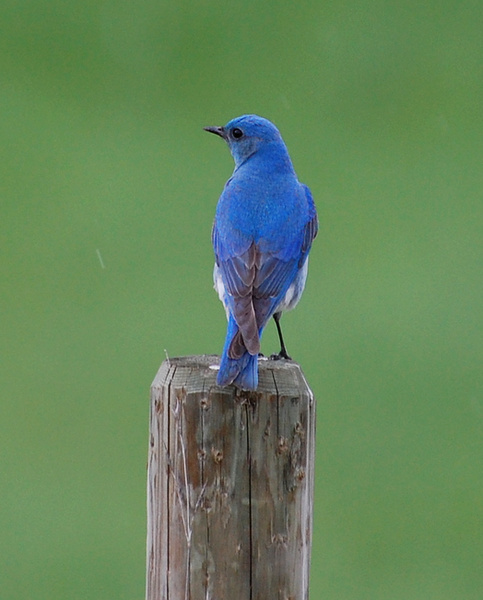
Mountain Bluebird
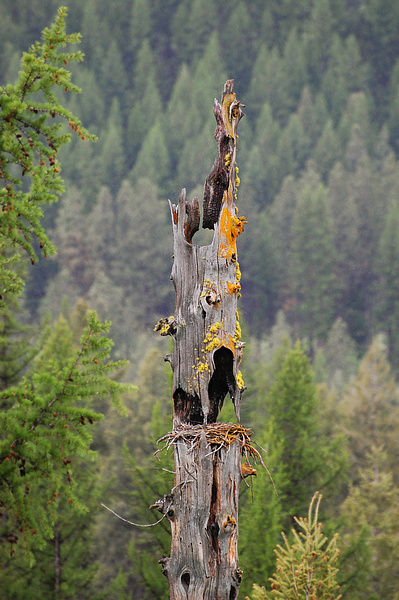
I photographed this old snag because I liked the orange and yellow lichen growing on it. I didn't noticed the bird's nest until now!
Okanagan Vacation 4 - Okanagan River bike path
June 18th, 2011
The Evening Grosbeak is a stunning burnt-yellow finch the size of a robin. It's hard to find in our area unless you know where to look--namely residential areas adjacent to Larose Forest, in fall and winter. If you don't typically get out that far, you can easily bird Ottawa for years and never see a one. I hadn't.
Well, I've found the motherload of Evening Grosbeaks. It is the West. In the south Okanagan in June it would take a concerted effort not to see an Evening Grosbeak! As I hiked a bike path along the river, whole flocks of them periodically filled the trees.
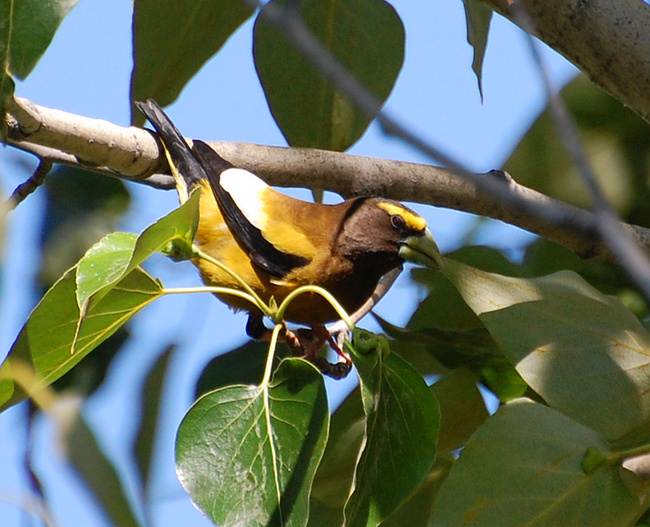
Trivia point: the greenish hue of the beak in the above photo is not an artifact--it's real. Evening Grosbeaks typically nest in spruces. The spring-green color of their conical bills evolved (so scientists think) to match the appearance of young green spruce cones, camouflaging them when they poke their heads up out of the nest. In winter the green is no longer useful and the bill changes to the color of bone.
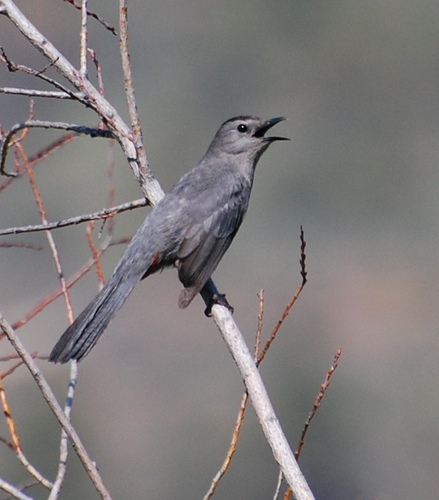
Gray Catbirds serenaded me from the riverbanks.
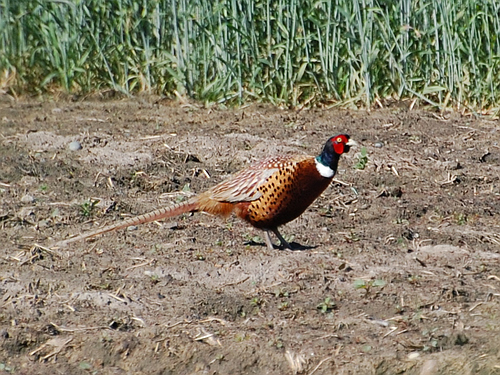
Ring-Necked Pheasants were common, though much more often heard than seen. This species was introduced from Eurasia in the 1800's and has since naturalized over many parts of North America. (Ottawa itself once had a small population. But our harsh winters wiped them out.) I spotted this one out in the open in a farmyard adjacent to the bike path. He quickly returned to cover when he noticed I was watching him.
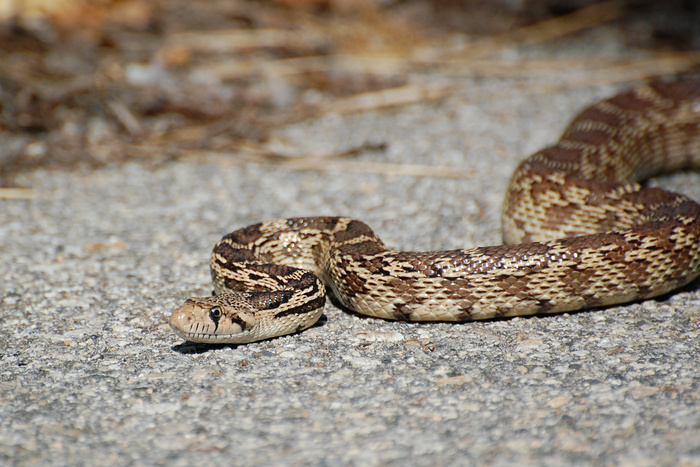
I found this guy basking on the bike path. Possibly the biggest snake I'd ever seen! It was a little intimidating as the south Okanagan does have rattlesnakes, but his head didn't have the triangular shape so I doubted it. Research back home indicates that this is a Great Basin Gopher Snake. Harmless to humans, not so harmless to rodents!
Apparently a Gopher Snake will do its best imitation of a rattlesnake if it feels threatened: flatten its head into a triangle, and shake its tail around in dead leaves to make it sound like a rattle. I guess this one didn't feel particularly threatened.
To show scale:

Okanagan Vacation 3 - Elm Tree Farm
June 17th, 2011
One of my first activities at ETF was chasing California Quail around the yard. They often came scratching for food on the lawn. They seemed tame from a distance--downright foolish where cars were concerned--but got skittish when you approached them, especially if you approached them with a purposeful gleam in your eye!
So I stalked 'em. Because quail spend most of their time on the ground, they tend not to notice you if there's an obstruction in the way. I put a woodpile between myself and one quail and slowly crept up on him. When he finally hopped up on the woodpile to take a look around, the startle response was comical.
Alas, I did not manage a shot during that golden moment when he was standing on the woodpile--but I did get a not-bad picture as he ran away.
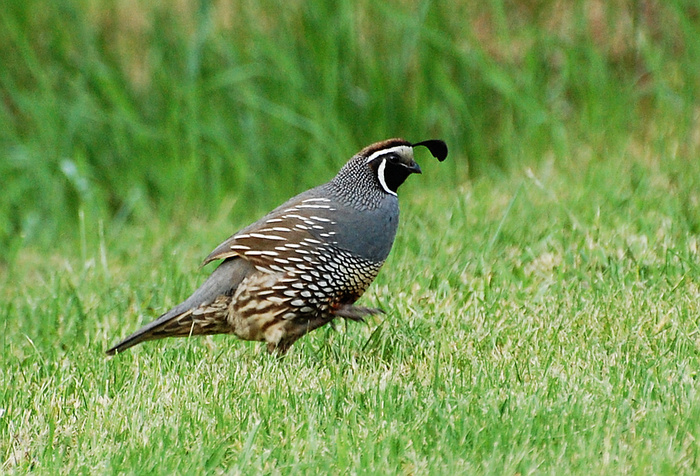
While I was hunting
It took me far longer than it should have to ID him. An interesting study in the danger of preconceived ideas. I had just finished reading Kingbird Highway. I remembered how Kaufman had moved west and fallen in love with Western Kingbirds, and how bold and visible he found them to be. Thought: well, this bird is bold and visible, and I've certainly fallen in love with it. It's a flycatcher with an orangey belly. Western Kingbird is a flycatcher with a yellowish belly. Must be a variation...?
The thing bobbed its tail constantly. "Just like an Eastern Phoebe!" I remember thinking. And why I didn't follow up on that thought, I don't know.
I knew in my heart that I didn't have the right ID. But I was mystified. As soon as I got a chance I described the bird to Tom and asked him about it. "Oh, the Say's Phoebes!" he said. "We've got a pair of them nesting on the house. Drive the cat crazy." I then looked up Say's Phoebe in my field guide and found the clearly visible picture in the flycatcher section that, indeed, looked exactly like my mystery bird. I had flipped past it about ten times on my way to the next page, where I had stared at the picture of Western Kingbird until blood ran from my forehead.
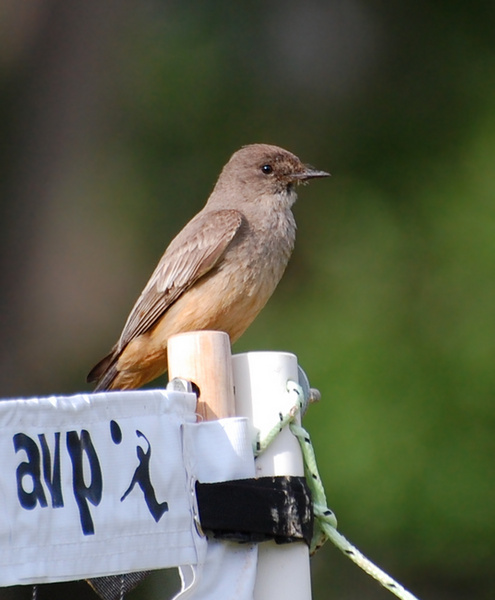
|
